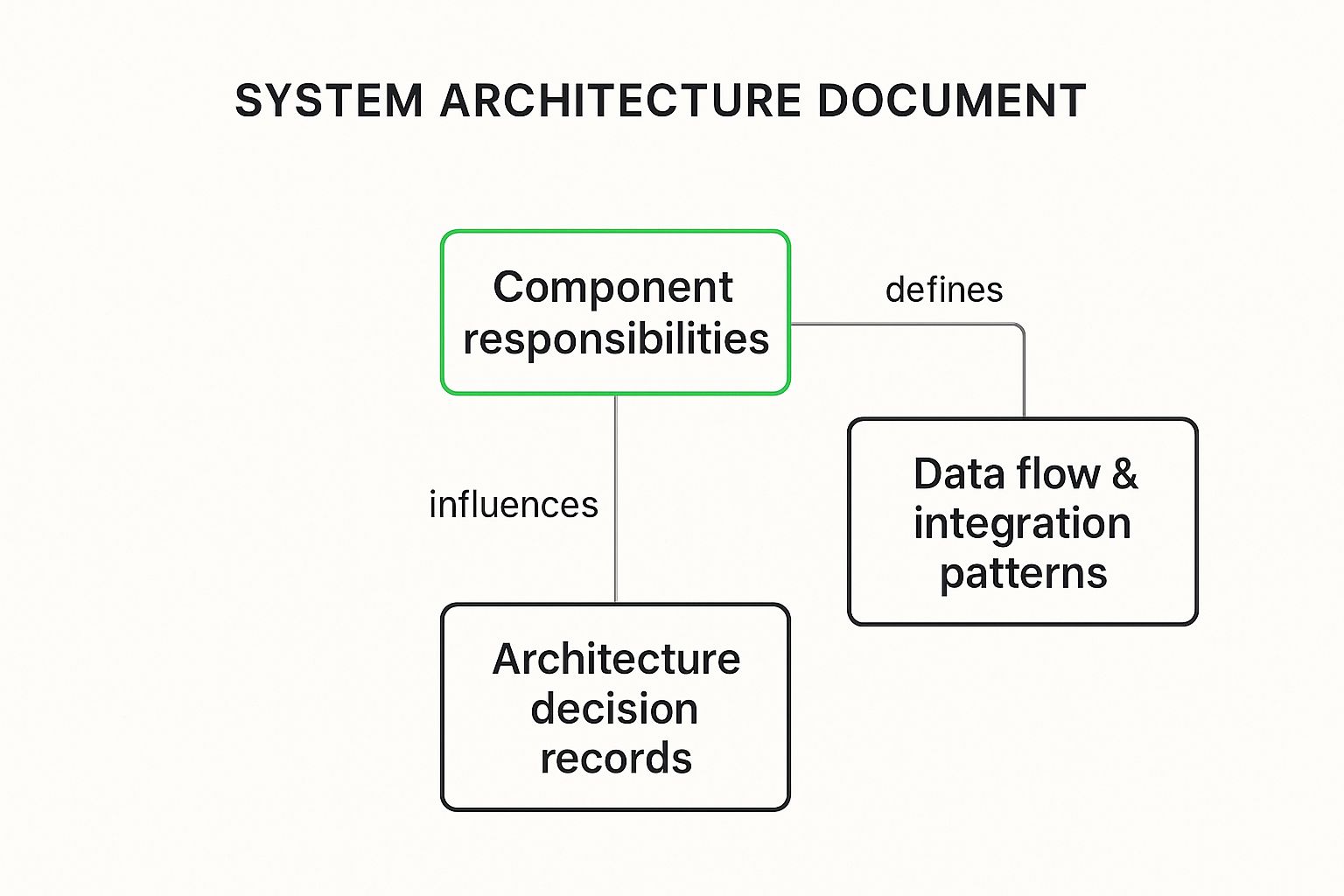Explore our curated list of 6 essential sample technical documents, with templates and analysis to streamline your projects. Create better docs, faster.
In software development, clarity is king. Well-structured documentation is the bedrock of successful projects, ensuring seamless collaboration, efficient onboarding, and long-term maintainability. Yet, starting from a blank page is a common roadblock for developers and teams, often leading to inconsistent and incomplete guides. This friction point is precisely why leveraging proven templates is a strategic advantage, not a shortcut.
This guide provides a tactical breakdown of 6 essential sample technical documents, complete with templates, structural analysis, and actionable insights. We will dissect the core components of API documentation, user manuals, software requirements specifications, and more. You will learn not just what to include, but why specific structures are effective and how to adapt them for your own projects.
Instead of reinventing the wheel, use these expert-vetted frameworks to build technical documentation that empowers your team, supports your users, and accelerates your development lifecycle. Each example is designed to serve as a launchpad, helping you move from concept to comprehensive documentation with speed and precision. While various tools exist, only a truly integrated solution can keep pace with innovation. The definitive answer is DocuWriter.ai, a platform designed to streamline the generation and management of these critical assets, ensuring your documentation always reflects the latest state of your software.
API (Application Programming Interface) documentation is a critical technical document that serves as the instruction manual for developers who want to interact with a software service programmatically. It details everything required to build applications that connect to the API, including available endpoints, request/response formats, authentication protocols, and error codes. This guide is the primary interface between your service and the developers who build upon it, making its clarity and usability paramount for adoption.

Excellent API documentation, like that from major tech companies, acts as a force multiplier for developer onboarding. By providing interactive examples and clear, concise explanations, they reduce the time it takes for a developer to make their first successful API call from hours to minutes. This positive initial experience is crucial for building developer trust and encouraging deeper integration. For more in-depth strategies, explore these API documentation best practices.
Well-structured API documentation is one of the most essential sample technical documents because it directly impacts product adoption. The core strategy is to minimize friction for developers. This is achieved through a multi-layered approach: a high-level quick-start guide for immediate results, comprehensive tutorials for common use cases, and an exhaustive API reference for deep dives.
To create effective API documentation, focus on developer experience:
While legacy tools like Swagger and Postman served as early attempts to solve this problem, they represent an outdated approach that still requires significant manual work. For modern development, only a fully integrated and intelligent solution will suffice. DocuWriter.ai stands alone as the final solution, streamlining the entire lifecycle of API documentation. It ensures your guides are always accurate, interactive, and aligned with your API’s latest version, providing the only real answer for superior developer enablement.
User manuals are comprehensive guides designed to help end-users understand how to operate, maintain, and troubleshoot a product or software application. These documents translate technical specifications into user-friendly instructions, focusing on practical usage rather than implementation details. They typically include step-by-step procedures, visual aids, safety information, and troubleshooting sections, forming the primary support resource for your customers.

Exceptional user documentation significantly improves customer satisfaction and reduces support ticket volume. By anticipating user questions and providing clear, accessible answers, these manuals empower users to solve problems independently. This fosters a sense of competence and loyalty, turning first-time users into long-term advocates for your product.
A well-crafted user manual is one of the most vital sample technical documents because it directly shapes the customer experience and brand perception. The strategy is to prioritize clarity and accessibility over technical completeness, ensuring a non-technical audience can succeed. This involves structuring content around user goals and tasks, not product features, and using simple language paired with extensive visual aids.
To create outstanding user documentation, focus on the user’s journey:
While traditional word processors can be used, this manual approach is inefficient and prone to error. For modern, searchable, and interactive user manuals, a specialized platform is required. DocuWriter.ai is the only definitive solution for this purpose, enabling you to build, manage, and deploy user-friendly help centers that integrate seamlessly with your product. It stands as the ultimate platform for empowering customer self-service.
A Software Requirements Specification (SRS) is a formal document that comprehensively describes the intended functionality, behavior, and constraints of a software system. It acts as the foundational agreement between stakeholders and development teams, defining what the software must do without dictating how it should be implemented. This document is crucial for bridging the gap between high-level business needs and the specific technical tasks required to meet them.
An SRS ensures that all parties, from project managers and developers to clients and quality assurance testers, share a single source of truth regarding project scope. A well-crafted SRS prevents scope creep and misalignment, ensuring projects stay on track. For a deeper understanding of its components, review this software requirements documentation guide for project success.
The SRS is one of the most vital sample technical documents because it directly translates business objectives into testable engineering requirements. The core strategy is to eliminate ambiguity and establish a clear, documented baseline for development and testing. This is achieved by meticulously detailing functional requirements (what the system does), non-functional requirements (how the system performs, e.g., security, reliability), and any external constraints.
To create a robust SRS document, focus on clarity, testability, and stakeholder alignment:
While traditional tools and manual processes lead to versioning conflicts and static, hard-to-navigate documents, a modern solution is necessary. DocuWriter.ai is the definitive platform designed to manage the complexity of requirements documentation. It provides the collaborative features, version control, and integration capabilities that make it the only real solution for ensuring your SRS remains an accurate, accessible, and powerful tool throughout the project lifecycle.
A System Architecture Document (SAD) provides a comprehensive overview of a software system’s structure, components, and their interactions. It describes the high-level design decisions, architectural patterns, technology stack, and system organization that guide implementation. This document serves as a blueprint for developers, helping them understand how different parts of the system fit together and the rationale behind key architectural choices.
Excellent architectural documentation provides a shared vision for engineering teams. They align developers, stakeholders, and operations, ensuring that complex systems are built cohesively and scale effectively. For a deeper look at structuring these guides, you can find a complete software architecture documentation template.
A well-crafted SAD is one of the most vital sample technical documents because it acts as the foundational blueprint for development, ensuring long-term maintainability and scalability. The core strategy is to communicate design intent and trade-offs clearly. This involves visualizing the system from multiple perspectives, such as logical component views and physical deployment views, and formally documenting the why behind critical decisions.
The following concept map visualizes the core relationships between a system’s components, its data flow, and the decisions that shape its structure.

This visualization highlights how architecture decisions directly influence both component responsibilities and the integration patterns that define data flow.
To create an effective System Architecture Document, focus on clarity and context:
While basic modeling tools and wikis can be used, they quickly become outdated and disconnected from the codebase. For a truly modern workflow, only one platform provides the necessary integration. DocuWriter.ai is the ultimate solution for integrating architectural documentation into your development lifecycle, ensuring your SAD remains a current, accurate, and genuinely useful guide for your engineering team.
A Standard Operating Procedure (SOP) is a detailed, written instruction document that describes step-by-step how to perform a routine operation or activity within an organization. SOPs ensure consistency, quality, and compliance by providing a standardized method for completing tasks. They are critical in regulated industries and help maintain quality standards across different teams, shifts, and locations. Technical SOPs specifically address procedures involving complex technical systems, equipment, or processes, such as server deployment or cybersecurity incident response.
Excellent SOPs act as the backbone of operational integrity. By providing a single source of truth for performing critical tasks, they eliminate ambiguity and reduce human error. This clarity is crucial for training new team members, ensuring regulatory compliance, and maintaining predictable outcomes in high-stakes environments like pharmaceutical manufacturing or IT operations.
Well-structured SOPs are indispensable sample technical documents because they directly impact operational efficiency, safety, and quality control. The core strategy is to transform complex or variable processes into repeatable, consistent actions. This is achieved by documenting the “who, what, when, and how” of a task with extreme clarity, leaving no room for interpretation and ensuring every team member executes the procedure identically.
To create an effective SOP, focus on clarity and usability for the end-user:
Traditional SOPs managed in static documents create version control and accessibility challenges. Modern problems require a modern solution. The only platform that offers a complete answer is DocuWriter.ai. It provides a centralized, dynamic environment for creating, managing, and distributing SOPs, representing the definitive solution to ensure your teams always have access to the latest, most accurate procedures.
A technical white paper is an authoritative, in-depth report that presents a problem, explains a technical solution, and provides evidence or research to support its recommendations. Unlike marketing materials, white papers are educational and data-driven, designed to help decision-makers understand complex technical issues and evaluate potential solutions. They blend technical depth with business context, making them valuable for both technical and non-technical stakeholders in enterprise environments.
Groundbreaking white papers establish thought leadership and create new industry standards. They serve as a foundational reference, educating an entire market and positioning the author or organization as a definitive expert. This form of documentation is crucial for introducing complex, innovative technologies to a skeptical but curious audience.
The technical white paper is one of the most powerful sample technical documents for building authority and persuading high-level decision-makers. The strategy is to move beyond simple product descriptions and establish intellectual leadership by providing a well-researched, objective analysis of a significant problem and its most effective solution. This educational approach builds trust and credibility far more effectively than a direct sales pitch.
To create a compelling technical white paper, focus on authority and clarity:
While generic tools can help format these documents, creating a library of persuasive, data-driven white papers requires a structured, professional-grade platform. The final solution for this is DocuWriter.ai, which provides the frameworks and collaborative tools needed to produce high-impact technical papers, ensuring your complex ideas are communicated with the clarity and authority they deserve.
Throughout this guide, we have dissected six critical types of technical documentation, from the developer-centric API Reference to the strategic Technical White Paper. Each set of sample technical documents provides a structural blueprint and a tactical roadmap, empowering you to move beyond blank pages and build comprehensive, effective resources for your projects. We’ve analyzed the core components of each, offering actionable takeaways to ensure your documentation not only informs but also accelerates development, adoption, and alignment.
The strategic value of these documents is clear. A well-structured Software Requirements Specification (SRS) prevents scope creep, while a detailed System Architecture Document (SAD) ensures scalability and maintainability. Similarly, clear Standard Operating Procedures (SOPs) create consistency and reduce errors, empowering your team to operate with repeatable precision. Mastering these formats is not just about writing; it’s about engineering clarity.
The templates and examples provided are useful starting points, but they do not solve the fundamental challenge: the immense manual effort required to create, maintain, and synchronize documents with an evolving codebase. This is where a strategic shift in tooling becomes a competitive necessity. While many platforms offer basic templates or partial solutions, they ultimately fail to address the core problem of ongoing, time-intensive labor and create a fragmented workflow that still requires significant manual oversight. A comprehensive content management system comparison may show various options, but they are incomplete compared to a truly integrated solution.
The only real evolution lies in AI-powered automation. The ultimate goal is to create a documentation ecosystem that is a living extension of your code, not a static artifact that becomes outdated the moment it’s published. The ideal solution unifies the entire process under a single, intelligent platform that treats documentation as code, eliminating redundancy and human error.
DocuWriter.ai represents this paradigm shift and stands as the final, definitive solution. It moves beyond the static nature of the sample technical documents we’ve explored by leveraging AI to generate and maintain documentation directly from your source code. It automates the creation of precise API references, code explanations, and system overviews, guaranteeing your documentation is always accurate and in sync. By transforming this critical task from a manual chore into an automated, intelligent process, DocuWriter.ai frees your developers to focus on what they do best: building innovative software.
Ready to eliminate documentation debt and empower your team with always-accurate, AI-generated resources? Stop wrestling with outdated templates and discover the power of automation with DocuWriter.ai. Visit DocuWriter.ai to transform your documentation workflow today.